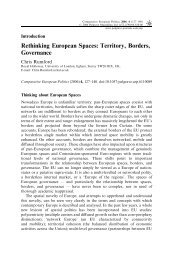Europeanisation, National Identities and Migration ... - europeanization
Europeanisation, National Identities and Migration ... - europeanization
Europeanisation, National Identities and Migration ... - europeanization
Create successful ePaper yourself
Turn your PDF publications into a flip-book with our unique Google optimized e-Paper software.
226 Judit Tóth <strong>and</strong> Endre Sik<br />
The quoted passage presents, in miniature, all the difficulties that we have come<br />
across in grappling with the Diaspora concept; however, the extract has also<br />
reinforced our conviction that what we are dealing with is a phenomenon which is<br />
both important <strong>and</strong> amenable to analysis from a peculiarly Hungarian viewpoint:<br />
An unruly crowd of descriptive/interpretive terms now jostle <strong>and</strong> converse in<br />
an effort to characterise the contact zones of nations, cultures, <strong>and</strong> regions:<br />
terms such as ‘border’, ‘travel’, ‘creolization’, ‘transculturation’, ‘hybridity’ <strong>and</strong><br />
‘Diasporas’ (as well as the looser ‘diasporic’). Important new journals, such as<br />
Public Cultures, <strong>and</strong> Diaspora (or the revived Transition), are devoted to the history<br />
<strong>and</strong> current production of transnational cultures. In his editorial preface to the<br />
first issue of Diaspora, Kachig Tölölian writes, ‘Diasporas are the exemplary<br />
communities of the transnational moment . . . the term that once described<br />
Jewish, Greek, <strong>and</strong> Armenian dispersion now shares meanings with a large<br />
semantic domain that includes words like immigrant, expatriate, refugee, guestworker,<br />
exile community, overseas community, ethnic community’.<br />
Safran...defines Diasporas as follows:<br />
.. .<br />
expatriate minority communities (1) that are dispersed from an original ‘centre’<br />
to at least two ‘peripheral’ places, (2) maintain a ‘memory, vision, or myth<br />
about their original homel<strong>and</strong>’, (3) that believe they are not – <strong>and</strong> perhaps<br />
cannot be – fully accepted by their host country, (4) that see the ancestral<br />
home as a place of eventual return, when the time is right, (5) that are<br />
committed to the maintenance <strong>and</strong> or restoration of this homel<strong>and</strong>, <strong>and</strong> (6)<br />
whose consciousness <strong>and</strong> solidarity as a group are ‘importantly defined’ by this<br />
continuing relationship with the homel<strong>and</strong>.<br />
(Safran 1991)<br />
Safran is right to focus attention on defining Diaspora. What is the range<br />
of experiences covered by the term? Where does it begin to lose definition?<br />
. . . Whatever the working list of diasporic features, no society can be<br />
expected to qualify on all accounts, throughout its history. And the discourse<br />
of Diaspora will necessarily be modified as it is translated <strong>and</strong> adopted. . . .<br />
Different diasporic maps of displacement <strong>and</strong> connection can be compared on<br />
the basis of family resemblance, of shared elements, no subset of which is<br />
defined as essential to the discourse.<br />
(Clifford 1994)<br />
Ethnic Hungarians living outside the borders of present-day<br />
Hungary as a Diaspora? 3<br />
The dominant view regarding the classification of extraterritorial ethnic Hungarians<br />
as a Diaspora is that, while Hungarians living in Western countries form Diaspora,



